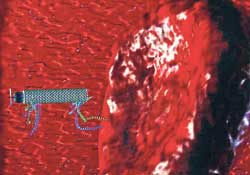
Building a safe nanotechnology futureWe are living - according to some - on the brink of a nanotechnology revolution, where matter is engineered at a scale thousands of times smaller than the eye can see, and familiar materials behave in unexpected ways. This revolution, if successful, will turn our world upside down. Nanotechnology gives us increasing control over the material world, providing opportunities to enhance existing technologies and develop new ones. The opportunities seem endless, from building stronger, lighter materials and manufacturing tremendously powerful yet incredibly small computers, to developing new sustainable energy sources and devising personalized cures for cancer.
More than 500 manufacturer-identified nanotechnology consumer products are now on the market, from cosmetics to car parts to tableware. By 2014 an estimated $2.6 trillion in manufactured goods around the world (or 15% of total global output) will use this technology, building on the research of scientists in some 100 nations around the world. If current projections are right, nanotechnology has the potential to have an impact on nearly every industry and virtually every aspect of our lives. Yet nanotechnology is also shaking up our understanding of what makes something harmful. At the nanometer scale (about 50,000 times smaller than the width of a human hair), matter behaves in unusual ways: weak materials become strong, inert materials become active, and benign materials become harmful. In the same way that iron can be made into products as different as skillets and swords, the usefulness or harmfulness of nanotechnology products depends on how they are crafted at the nanometer scale. As a result, we can no longer rely on conventional ways of managing risk that are based on the raw materials alone. As the number of products using nanotechnology continues to grow, we need new scientific information on the risks that they might present. Experts in government, industry, academia, and elsewhere agree that a long list of questions needs to be addressed if we are to develop nanotechnology as safely as possible. The challenge we face is to find answers that will enable producers and regulators to make sound, science-based decisions, and to develop an oversight system that inspires consumer confidence. Unfortunately, the global response to this challenge has not been overwhelming. In 2005, the Woodrow Wilson International Center for Scholars Project on Emerging Nanotechnologies looked closely at government-funded research addressing the environmental, health, and safety impact of nanotechnology. Investment in highly relevant research was low: in the United States, it was only an estimated 1% of the $1.1 billion federal investment in nanotechnology research and development. More worrying was the apparent absence of any strategy behind the research being funded. Even the small handful of relevant studies exploring possible risks lacked a guiding focus, giving no indication that the information developed would help decision-makers ensure that nanotechnology is developed safely over the long term. The US has been tremendously successful in promoting research strategies that support the use of nanotechnology, and has served as a model that is being duplicated around the world. But the same strategies that work for developing nanotechnology applications will not help answer the growing list of questions about its possible impact that governments and industry are asking today. Pressing risk-related questions require deliberate action on an international scale. They will be answered only by matching research efforts and funding levels to the information needed to steer toward a safe future for nanotechnology applications. In 2006, five research grand challenges for developing safe nanotechnology were published in the scientific journal Nature: * finding ways to measure the amount of nanomaterials in the air and water; Some nations and regions are beginning to develop research agendas that respond to these five challenges. For example, the European Union has recently announced a €3.6 billion nanotechnology research programme, which includes environment, health, and safety goals that align with these challenges. Likewise, in March 2007, the British government's top advisory body on science and technology warned that the country's lead in nanotechnology is fading, because the government has not invested enough in research necessary for understanding and effectively managing possible health and environmental effects. There is still a long way to go. If sustainable nanotechnology is to be built on sound science, global research strategies must be supported by innovative policies and accompanied by sufficient funds to do the job. In the US alone, estimates of the necessary funding levels for goal-oriented nanotechnology risk research are between $50 million and $100 million per year - five to ten times the amount invested in 2005. We cannot afford to drive blind into the nanotechnology future. Despite a good start, many countries are developing these twenty-first century technologies within an old and blinkered mindset. If we do not develop the ways and means to spot and navigate around possible new risks, the outlook for this exciting new technology will be uncertain. We must wake up to the need for future nanotechnology applications to be based on a sound understanding of the possible impact. In the global race for nanotechnology leadership, the winners will be those who understand the risks and support the research necessary to minimize them. (Andrew D. Maynard is Chief Science Advisor of the Project on Emerging Nanotechnologies at the Woodrow Wilson International Center for Scholars.) Copyright: Project Syndicate, 2007. Exclusive to The Sunday Times |
|| Front
Page | News | Editorial | Columns | Sports | Plus | Financial
Times | International | Mirror | TV
Times | Funday
Times || |
| |
Reproduction of articles permitted when used without any alterations to contents and the source. |
© Copyright
2007 | Wijeya
Newspapers Ltd.Colombo. Sri Lanka. All Rights Reserved. |
